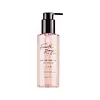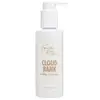What's inside
What's inside
 Key Ingredients
Key Ingredients

 Benefits
Benefits

 Concerns
Concerns

 Ingredients Side-by-side
Ingredients Side-by-side

Water
Skin ConditioningSodium Lauroyl Methyl Isethionate
CleansingGlycerin
HumectantPolysorbate 20
EmulsifyingDecyl Glucoside
CleansingCocamidopropyl Hydroxysultaine
CleansingCocamidopropyl Betaine
CleansingDisodium Laureth Sulfosuccinate
CleansingLitchi Chinensis Fruit Extract
Skin ConditioningHedychium Coronarium Root Extract
MaskingLotus Corniculatus Flower Extract
MaskingHydrolyzed Jojoba Protein
Skin ConditioningQuartz
AbrasiveRose Extract
Skin ConditioningCamellia Sinensis Leaf Extract
AntimicrobialLavandula Angustifolia Flower/Leaf/Stem Extract
MaskingCupressus Sempervirens Leaf/Stem Extract
Skin ConditioningJasminum Officinale Flower/Leaf Extract
MaskingCitrus Aurantium Bergamia Fruit Extract
Skin ConditioningCitrus Aurantium Amara Flower Extract
RefreshingMorus Indica Flower Extract
Prunus Amygdalus Dulcis Seed Extract
Skin ConditioningRosmarinus Officinalis Leaf Extract
AntimicrobialSalvia Officinalis Leaf Extract
CleansingPyrus Malus Fruit Extract
Skin ConditioningCucumis Sativus Fruit Extract
EmollientCucumis Melo Fruit Extract
Skin ConditioningCananga Odorata Flower Extract
PerfumingCoffea Arabica Leaf/Seed Extract
MaskingCucumis Melo Cantalupensis Fruit Extract
AstringentSodium Chloride
MaskingPanthenol
Skin ConditioningCaprylic/Capric Triglyceride
MaskingCocamide Mipa
EmulsifyingDisodium Lauryl Sulfosuccinate
CleansingHydroxypropyl Guar Hydroxypropyltrimonium Chloride
Trisodium EDTA
Potassium Sorbate
PreservativeCaprylyl Glycol
EmollientHexylene Glycol
EmulsifyingPhenoxyethanol
PreservativeCI 19140
Cosmetic ColorantCI 14700
Cosmetic ColorantCI 60730
Cosmetic ColorantWater, Sodium Lauroyl Methyl Isethionate, Glycerin, Polysorbate 20, Decyl Glucoside, Cocamidopropyl Hydroxysultaine, Cocamidopropyl Betaine, Disodium Laureth Sulfosuccinate, Litchi Chinensis Fruit Extract, Hedychium Coronarium Root Extract, Lotus Corniculatus Flower Extract, Hydrolyzed Jojoba Protein, Quartz, Rose Extract, Camellia Sinensis Leaf Extract, Lavandula Angustifolia Flower/Leaf/Stem Extract, Cupressus Sempervirens Leaf/Stem Extract, Jasminum Officinale Flower/Leaf Extract, Citrus Aurantium Bergamia Fruit Extract, Citrus Aurantium Amara Flower Extract, Morus Indica Flower Extract, Prunus Amygdalus Dulcis Seed Extract, Rosmarinus Officinalis Leaf Extract, Salvia Officinalis Leaf Extract, Pyrus Malus Fruit Extract, Cucumis Sativus Fruit Extract, Cucumis Melo Fruit Extract, Cananga Odorata Flower Extract, Coffea Arabica Leaf/Seed Extract, Cucumis Melo Cantalupensis Fruit Extract, Sodium Chloride, Panthenol, Caprylic/Capric Triglyceride, Cocamide Mipa, Disodium Lauryl Sulfosuccinate, Hydroxypropyl Guar Hydroxypropyltrimonium Chloride, Trisodium EDTA, Potassium Sorbate, Caprylyl Glycol, Hexylene Glycol, Phenoxyethanol, CI 19140, CI 14700, CI 60730
Water
Skin ConditioningDisodium Laureth Sulfosuccinate
CleansingCaprylic/Capric Triglyceride
MaskingCocamidopropyl Hydroxysultaine
CleansingGlycerin
HumectantButylene Glycol
HumectantStearic Acid
CleansingSodium Lauryl Sulfoacetate
CleansingPrunus Amygdalus Dulcis Oil
Skin ConditioningGlycol Distearate
EmollientSimmondsia Chinensis Seed Oil
EmollientRosa Damascena Flower Water
MaskingRose Extract
Skin ConditioningRhododendron Ferrugineum Extract
MaskingArgania Spinosa Kernel Oil
EmollientHydrolyzed Jojoba Protein
Skin ConditioningSqualane
EmollientPhospholipids
Skin ConditioningSodium Hyaluronate
HumectantAnthemis Nobilis Flower Extract
MaskingCucumis Melo Cantalupensis Fruit Extract
AstringentLavandula Angustifolia Flower/Leaf/Stem Extract
MaskingAngelica Archangelica Root Extract
MaskingLilium Candidum Bulb Extract
Skin ConditioningSantalum Album Wood Extract
PerfumingPropanediol
SolventQuartz
AbrasiveXanthan Gum
EmulsifyingCocamidopropyl Dimethylamine
EmulsifyingPolyglyceryl-10 Oleate
Skin ConditioningPolyglyceryl-10 Dioleate
EmulsifyingSodium C10-16 Pareth-2 Sulfate
CleansingCaprylyl Glycol
EmollientHexylene Glycol
EmulsifyingPotassium Sorbate
PreservativePhenoxyethanol
PreservativeWater, Disodium Laureth Sulfosuccinate, Caprylic/Capric Triglyceride, Cocamidopropyl Hydroxysultaine, Glycerin, Butylene Glycol, Stearic Acid, Sodium Lauryl Sulfoacetate, Prunus Amygdalus Dulcis Oil, Glycol Distearate, Simmondsia Chinensis Seed Oil, Rosa Damascena Flower Water, Rose Extract, Rhododendron Ferrugineum Extract, Argania Spinosa Kernel Oil, Hydrolyzed Jojoba Protein, Squalane, Phospholipids, Sodium Hyaluronate, Anthemis Nobilis Flower Extract, Cucumis Melo Cantalupensis Fruit Extract, Lavandula Angustifolia Flower/Leaf/Stem Extract, Angelica Archangelica Root Extract, Lilium Candidum Bulb Extract, Santalum Album Wood Extract, Propanediol, Quartz, Xanthan Gum, Cocamidopropyl Dimethylamine, Polyglyceryl-10 Oleate, Polyglyceryl-10 Dioleate, Sodium C10-16 Pareth-2 Sulfate, Caprylyl Glycol, Hexylene Glycol, Potassium Sorbate, Phenoxyethanol
Ingredients Explained
These ingredients are found in both products.
Ingredients higher up in an ingredient list are typically present in a larger amount.
This ingredient is an emollient, solvent, and texture enhancer. It is considered a skin-softener by helping the skin prevent moisture loss.
It helps thicken a product's formula and makes it easier to spread by dissolving clumping compounds.
Caprylic Triglyceride is made by combining glycerin with coconut oil, forming a clear liquid.
While there is an assumption Caprylic Triglyceride can clog pores due to it being derived from coconut oil, there is no research supporting this.
Learn more about Caprylic/Capric TriglycerideCaprylyl Glycol is a humectant and emollient, meaning it attracts and preserves moisture.
It is a common ingredient in many products, especially those designed to hydrate skin. The primary benefits are retaining moisture, skin softening, and promoting a healthy skin barrier.
Though Caprylyl Glycol is an alcohol derived from fatty acids, it is not the kind that can dry out skin.
This ingredient is also used as a preservative to extend the life of products. It has slight antimicrobial properties.
Learn more about Caprylyl GlycolCocamidopropyl Hydroxysultaine is a synthetic cleansing agent, though it is derived from coconut oil.
It is used to enhance the texture of products by boosting lather and thickening the texture. As a cleanser, Cocamidopropyl Hydroxysultaine is mild.
We don't have a description for Cucumis Melo Cantalupensis Fruit Extract yet.
This ingredient is a cleansing agent, surfactant, and foam booster. It considered an alternative to traditional sulfates (Sulfosuccinate) and is allowed in "sulfate-free" products.
According to a manufacturer, this ingredient is mild and can be used in baby and bath options.
Glycerin is already naturally found in your skin. It helps moisturize and protect your skin.
A study from 2016 found glycerin to be more effective as a humectant than AHAs and hyaluronic acid.
As a humectant, it helps the skin stay hydrated by pulling moisture to your skin. The low molecular weight of glycerin allows it to pull moisture into the deeper layers of your skin.
Hydrated skin improves your skin barrier; Your skin barrier helps protect against irritants and bacteria.
Glycerin has also been found to have antimicrobial and antiviral properties. Due to these properties, glycerin is often used in wound and burn treatments.
In cosmetics, glycerin is usually derived from plants such as soybean or palm. However, it can also be sourced from animals, such as tallow or animal fat.
This ingredient is organic, colorless, odorless, and non-toxic.
Glycerin is the name for this ingredient in American English. British English uses Glycerol/Glycerine.
Learn more about GlycerinHexylene Glycol is a surfactant. Glycols are a class of alcohols. Hexylene Glycol is a surfactant and emulsifier.
As a surfactant, Hexylene Glycol helps gather dirt and oil on your skin to be washed away.
As an emulsifier, Hexylene Glycol helps keep water and oil together. This prevents them from separating in a product. Hexylene Glycol also thins out the texture of a product by lessening viscosity.
Hexylene Glycol has a small molecular weight.
Learn more about Hexylene GlycolWe don't have a description for Hydrolyzed Jojoba Protein yet.
This ingredient comes from the lavender plant. It is used to add a scent or mask an unpleasant one in products.
Lavender contains linalool and linalyl acetate.
When exposed to air, these two compounds become strong allergens. This ingredient exhibits cytotoxicity at low concentrations; amounts of 0.25% have been shown to damage skin cells.
Learn more about Lavandula Angustifolia Flower/Leaf/Stem ExtractPhenoxyethanol is a preservative that has germicide, antimicrobial, and aromatic properties. Studies show that phenoxyethanol can prevent microbial growth. By itself, it has a scent that is similar to that of a rose.
It's often used in formulations along with Caprylyl Glycol to preserve the shelf life of products.
Potassium Sorbate is a preservative used to prevent yeast and mold in products. It is commonly found in both cosmetic and food products.
This ingredient comes from potassium salt derived from sorbic acid. Sorbic acid is a natural antibiotic and effective against fungus.
Both potassium sorbate and sorbic acid can be found in baked goods, cheeses, dried meats, dried fruit, ice cream, pickles, wine, yogurt, and more.
You'll often find this ingredient used with other preservatives.
Learn more about Potassium SorbateThis ingredient comes from multiple species of rose.
According to a manufacturer, this ingredient contains vitamins A, C, E, and flavonoids, giving it antioxidant properties.
Water. It's the most common cosmetic ingredient of all. You'll usually see it at the top of ingredient lists, meaning that it makes up the largest part of the product.
So why is it so popular? Water most often acts as a solvent - this means that it helps dissolve other ingredients into the formulation.
You'll also recognize water as that liquid we all need to stay alive. If you see this, drink a glass of water. Stay hydrated!
Learn more about Water